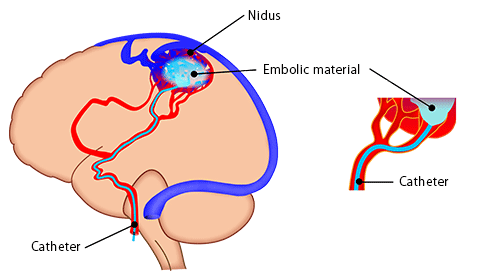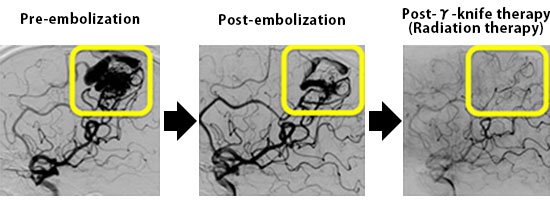- HOME
- For Patients
- Cerebral arteriovenous malformation
- Treatment of cerebral arteriovenous malformation
Cerebral arteriovenous malformation
- About cerebral arteriovenous malformation
- Symptom of cerebral arteriovenous malformation
- Diagnosis of cerebral arteriovenous malformation
- Treatment of cerebral arteriovenous malformation
Treatment of cerebral arteriovenous malformation
Craniotomy, radiotherapy, and catheterization
Cerebral arteriovenous malformations cannot be treated with drugs; therefore, surgery is performed to prevent hemorrhage. The objective of this surgery is both to reduce the risk of a recurrence of hemorrhage (called "rebleeding") in cerebral arteriovenous malformations that have already hemorrhaged, and to reduce the risk of future hemorrhage in those that have not previously hemorrhaged. If an intracerebral hemorrhage has occurred, surgery may be performed as treatment. Anticonvulsant medication may also be necessary if seizures have occurred.
Craniotomy
After a detailed diagnosis by cerebral angiography, the malformation is removed via craniotomy (surgery involving opening part of the skull to directly observe the lesion). The main part of a cerebral arteriovenous malformation has no connection with supplying brain cells, so in this surgery, the entrance (the arteries involved in blood supply to the surrounding healthy brain cells and the branch artery leading to the lesion) and exit (the veins into which only blood from the lesion drains and the point of fusion with veins containing blood flowing from surrounding healthy brain cells) are identified, clamped, and resected. A grading system has been devised for categorizing lesions based on the degree of treatment difficulty in accordance with their size and location, as well as the location of the exit. Lesions vary from those that can be safely and completely removed with surgery to those that are exceptionally difficult to treat.
Radiotherapy (Gamma Knife)
Radiotherapy is used for lesions in locations that are difficult to treat surgically. In particular, the "Gamma Knife" technique is a therapeutic procedure for blocking arteriovenous malformations by providing accurate, concentrated radiotherapy to small lesions.
Catheter embolization
A fine tube called a "catheter" is inserted via a blood vessel in the groin (the femoral artery) and passed through the vessels until it reaches the entrance to the malformed vessel in the head. An embolic substance (a liquid medication that blocks the blood vessel) is passed through the catheter to block the main part of the cerebral arteriovenous malformation and the vessels that provide it with blood. As this treatment can be performed without opening the skull, it constitutes minimally invasive surgery (which thus imposes less of a physical burden on the patient). Some lesions are treatable with catheterization alone; however, catheterization may also be combined with Gamma Knife therapy or craniotomy. At Tokai University Hospital, based on our rich experience, we actively utilize this therapeutic technique to provide safe and effective treatment.
[ Catheter embolization of cerebral arteriovenous malformation ]


A main part of a cerebral arteriovenous malformation is occluded using liquid embolic material through an intraarterial catheter. After g-knife therapy, the AVM disappeared completely.
Catheter embolization involves filling up the arteriovenous malformation and reducing its size. The remaining portion can be treated with a Gamma Knife (radiotherapy), after which the arteriovenous malformation disappears on angiography.







